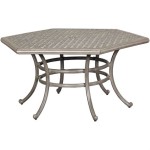Essential Aspects of Patio Herb Gardens
Patio herb gardens are a fantastic way to bring the freshness of nature and the vibrant flavors of herbs to your doorstep. By incorporating some key elements, you can design a flourishing herb garden that will not only beautify your outdoor space but also provide you with a culinary treasure trove.
1. Choosing Suitable Herb Types:
When selecting herbs for your patio garden, consider your culinary preferences and the amount of sunlight your patio receives. Basil, parsley, cilantro, thyme, and rosemary thrive in ample sunlight, while mint, chives, and oregano prefer partial shade. Choose a mix of herbs to cater to your cooking needs and create a visually appealing display.
2. Container Selection:
The choice of containers is critical for the health of your herbs. Choose containers with drainage holes to prevent waterlogging, and consider the size of the plants and their root systems. Terracotta pots, clay pots, or raised beds are excellent options that provide good drainage and aeration.
3. Soil Preparation:
Herbs require well-drained soil with a pH level between 6.0 and 7.0. Amend the soil with organic matter such as compost or peat moss to improve drainage and fertility. Using a soil-testing kit to determine the pH level of your soil will help you make necessary adjustments.
4. Watering and Fertilizing:
Water your herbs regularly, especially during hot and dry weather. Allow the soil to dry out slightly between waterings to prevent root rot. Fertilize your herbs every few weeks with a balanced liquid fertilizer to provide them with essential nutrients.
5. Sunlight Requirements:
Most herbs need at least 6 hours of direct sunlight per day. If your patio receives less sunlight, choose herbs that can tolerate partial shade, such as mint, chives, and oregano. Place them in areas with the most sunlight available.
6. Pest Control:
Pests can occasionally bother your herb garden. Inspect your plants regularly and use organic methods to control pests, such as spraying them with insecticidal soap or introducing beneficial insects like ladybugs.
7. Harvesting Herbs:
Harvest herbs regularly to encourage new growth and prevent them from becoming woody. Use sharp scissors or shears to cut stems just above a leaf node. Regular harvesting will keep your herbs healthy and productive throughout the growing season.
8. Overwintering Herbs:
In colder climates, perennial herbs like thyme, rosemary, and sage can be overwintered by providing them with protection from extreme cold. Move them to a sheltered location, such as a greenhouse or garage, and reduce watering. Alternatively, you can dig up the entire plant and pot it indoors for the winter.
By following these essential aspects, you can create a thriving patio herb garden that will provide you with an abundance of fresh, flavorful herbs. Enjoy the convenience of having herbs readily available and delight in the beauty and aroma they bring to your outdoor oasis.
How To Start A Balcony Herb Garden Access S

How To Make A Balcony Herb Garden Complete Tutorial

Easy Diy Patio Herb Garden Step By With S

How To Start A Balcony Herb Garden Access S

26 Ive Diy Porch Herb Garden Ideas Balcony Web

25 Pretty Herb Garden Ideas Trees Com

Diy Vertical Herb Garden Love Renovations
Starting An Herb Garden For The Love Of Wonder

Herb Garden Design Ideas And Growing Tips
Starting An Herb Garden For The Love Of Wonder








